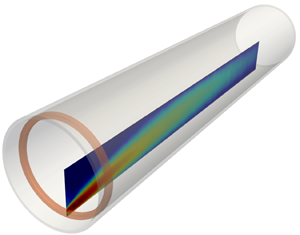Article contents
Relaxation of turbulent pipe flow downstream of a square bar roughness element
Published online by Cambridge University Press: 19 July 2021
Abstract

The relaxation of turbulent pipe flow downstream of a single square bar roughness element is studied at distances up to  $120R$ (
$120R$ ( $R$ is the pipe radius). Three bar heights,
$R$ is the pipe radius). Three bar heights,  $h/R = 0.04$, 0.1 and 0.2, are investigated. The data suggest three stages for the relaxing flow. Immediately following the square bar is the development of a separated shear layer, where we find that the peak Reynolds stress scales linearly with
$h/R = 0.04$, 0.1 and 0.2, are investigated. The data suggest three stages for the relaxing flow. Immediately following the square bar is the development of a separated shear layer, where we find that the peak Reynolds stress scales linearly with  $h/R$ and the disturbance profile is characterised by
$h/R$ and the disturbance profile is characterised by  $h$. The bulk shear stress and turbulence intensity in this stage scale as
$h$. The bulk shear stress and turbulence intensity in this stage scale as  $(h/R)^{2}$ and reach their maximum near the reattachment point. The second stage features the redistribution of turbulence towards the pipe centre and a power law in the decay of turbulence. The extent of this region is characterised by a streamwise length scale,
$(h/R)^{2}$ and reach their maximum near the reattachment point. The second stage features the redistribution of turbulence towards the pipe centre and a power law in the decay of turbulence. The extent of this region is characterised by a streamwise length scale,  ${x_c}$, which measures the extent of the redistribution process. The final stage of recovery is found to be long-lasting and oscillatory owing to asynchronous recovery between the mean velocity and the Reynolds stress. The oscillation wavelength scales with
${x_c}$, which measures the extent of the redistribution process. The final stage of recovery is found to be long-lasting and oscillatory owing to asynchronous recovery between the mean velocity and the Reynolds stress. The oscillation wavelength scales with  ${x_c}$ and decreases with increasing
${x_c}$ and decreases with increasing  $h/R$. In contrast, the deficits in the mean shear and the bulk shear stress increase with
$h/R$. In contrast, the deficits in the mean shear and the bulk shear stress increase with  $h/R$. For all three bar sizes, the flow recovery is not complete until the streamwise distance exceeds 500
$h/R$. For all three bar sizes, the flow recovery is not complete until the streamwise distance exceeds 500 $h$–1000
$h$–1000 $h$.
$h$.
JFM classification
Information
- Type
- JFM Papers
- Information
- Copyright
- © The Author(s), 2021. Published by Cambridge University Press
References
REFERENCES
- 7
- Cited by


